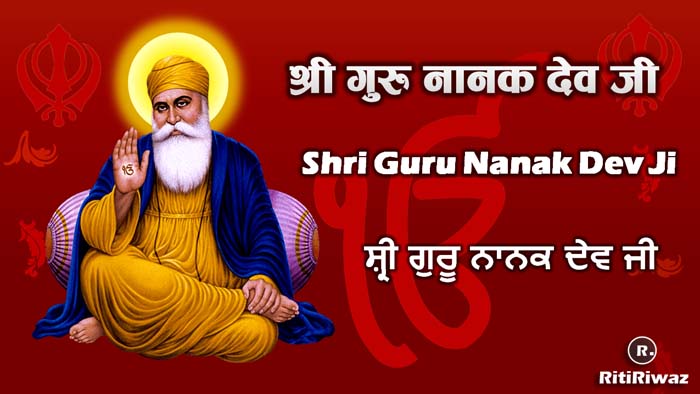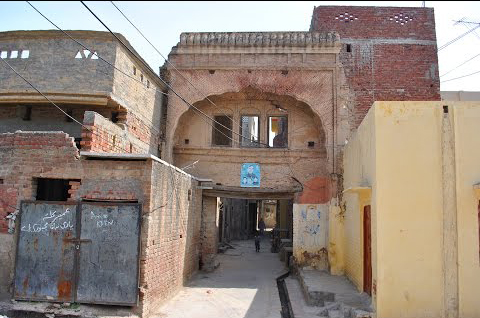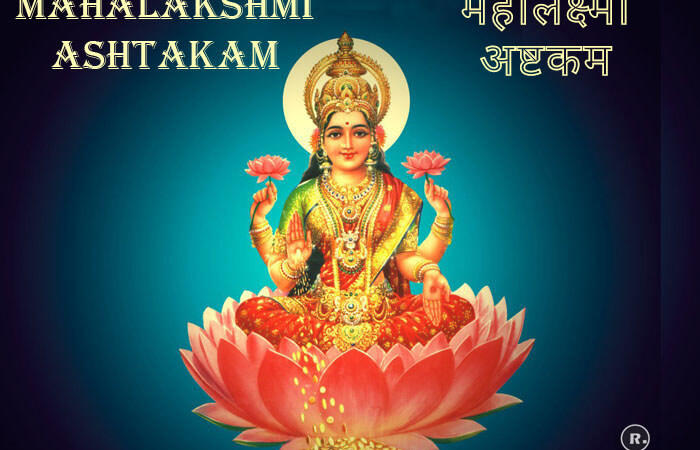Biography of Guru Nanak Dev (1469-1539)

Guru Nanak is the first Guru of Sikhs. His followers address him by the names Guru Nanak, Guru Nanak Dev Ji, Baba Nanak, and Nanakshah. He is also known as Nanak Lama in Ladakh and Tibet. Guru Nanak possessed the qualities of a philosopher, yogi, householder, religious reformer, social reformer, poet, patriot, and Vishwabandhu – all in his personality. He preaches to people the message of ik onkar (ੴ, ‘one God’) who dwells in every one of his creations and constitutes the eternal Truth. His teachings were immortalized in the form of 974 hymns, which came to be known as ‘Guru Granth Sahib,’ the holy text of Sikhism.
Fast Facts
Name: Nanak
Famous name: Shree Guru Nanak Dev Ji
Birth: 15 April 1469
Place of Birth: Rai Bhoi di Talwandi (Now in Pakistan)
Father: Kalyan Chand Das Bedi (Mehta Kalu)
Mother: Mata Tripta
Sister: Nanaki
Marriage: 24th September 1487
Wife: Mata Sulakhani
Children: Two sons, Sri Chand and Lakhmi Chand
Death: September 22, 1539
Death Place: Kartarpur, Mughal Samrajya, Pakistan.
Indian spiritual teacher: Founder of Sikhism
Spiritual successor: Guru Angad
Early Life

Nanak was born in Katak on Kartik Purnima in a village called Talwandi situated on the banks of the Ravi river. Some scholars consider his date of birth as April 15, 1469, in Baisakh month. But the prevailing date is Kartik Purnima, which falls in October-November, 15 days after Diwali. He belongs to a middle-class Hindu family, his father’s name was Kalyan Chand Das Bedi commonly known as Mehta Kalu, and his mother’s name was Mata Tripta. His sister’s name was Nanaki she was five years older than him.

Since childhood, Guru Nanak had many qualities like spiritual, prudent, and thoughtful. He learned Hindi and Sanskrit at the age of seven. He used to be indifferent to worldly subjects from childhood and was an extraordinary child. Young Nanak used to astound his teachers with his knowledge of divine matters. He refused to partake in traditional religious rituals and spent all his time in spiritual contemplation and Satsang.
Guru Nanak used to be immersed in his thoughts. His father then engaged him in business. A small shop was opened for them in the village. One day, the father gave him 20 rupees and asked him to get a good deal from the market. Nanak gave food to some hungry sadhus found on the way with that money and came and told the father that he had got ‘true deal’.
By the age of 16, he had become the most educated and knowledgeable in the state around him. Nanak Ji also knew about the scriptures of Islam, Christianity, and Judaism. Many miraculous incidents happened during childhood, which the people of the village started seeing them as divine personalities. He had mastered various languages including Sanskrit, Persian, and Hindi.
Suggested Read: Birthday of Guru Nanak Dev Ji
Nanak married Sulakhani at a young age on 24 September 1487 and had two sons Sri Chand and Lakhmi Das, one was born in the year 1491 and the other in 1496. In 1485 he took up, at the instance of his brother-in-law, the appointment of an official in charge of the stores of Daulat Khan Lodhi, the Muslim ruler of the area at Sultanpur. It is there that he came into contact with Mardana, a Muslim minstrel (Mirasi) who was senior in age.

The year 1496 was the year of his enlightenment when Guru Nanak started his mission by meeting with Mardana. Along with this message, he campaigned vigorously to help the weak. With this, he campaigned against caste discrimination, idol worship, and pseudo-religious beliefs. He left his home to propagate his principles and rules and started living as a monk. He founded a new religion incorporating the ideas of both Hindu and Muslim religions which later became known as Sikhism.
He was a strong supporter of Hindu-Muslim unity. To establish religious harmony, he visited all pilgrimages and made people of all religions his disciples. By combining the basic and best teachings of both Hinduism and Islam, he established a new religion with love and equality. This was later called Sikhism. After lighting the flame of his knowledge in India, he traveled to Mecca Medina and the residents were also very impressed by him. After 25 years of travel, Nanak settled in Kartarpur and started teaching there. His speech is still stored in ‘Guru Granth Sahib‘.
In the year 1507, Nanak sat for meditation and heard God’s call to give his life for world-uplift, guiding men on the right path to Him. He at once decided to obey the call resigned from his post and gave everything he had to the poor and prepared to set foot out. When Nanak Ji left for the yatra, four of his companions namely Mardana, Lahna, Bala, and Ramdas also accompanied him for the yatra. After this, by 1521, Nanak Ji completed three travel cycles in which he visited the main places of India, Afghanistan, Persia, and Arabia. These visits of Guru Nanak are called ‘Udasi’ (Vichharan Yatra) in Punjabi.
For 14 years, from 1507-1510 he traveled around the then known world and spread the message of God. In history, he is the most traveled of all the known prophets. (Jesus traveled in the central plains of Palestine; Mohammed traveled from Mecca to Medina and back to Mecca; Moses traveled from Egypt to the outskirts of Palestine; Ram traveled from Ayodhya to Sri Lanka; Krishna traveled from Mathura to Dwarka). Guru Nanak traveled as far as Tibet in the north, Sri Lanka in the south, Mecca in the west, and Dhaka in the east to deliver God’s message. He was welcomed wherever he went. He met both kings and robbers, gave them the message of God, and reformed them. He is the only prophet in the world who did not meet any violent opposition and was not harmed by the enemies. In fact, he had no enemies.
Nanak was an altruist. He considered idolatry meaningless. He was always in opposition to stereotypes and rituals. According to them, the Interview of God is possible not by external means but by internal cultivation. Not only is there quietness in his philosophy, but he has also looked at the political, religious, and social conditions of the time. In saint literature, Nanak is in the category of saints who have given nobility to women.
The essence of his sermon was that God is one and his worship is for both Hindu Muslims. Guru Nanak Sahib believed that God resides in every person. Therefore, we should not discriminate against each other on the basis of religion, caste, sex, state. He said that Seva-Arpan, Satsang, and Kirtan are the basic concepts of Sikhism as the Almighty God. The teachings of Nanak Dev Sahib are present in Guru Granth Sahib.
Death

In the last days of his life, his fame increased greatly and his thoughts also changed. He established a city called Kartarpur, which is now in Pakistan, and built a large Dharamshala in Kartarpur, Pakistan. He appointed Bhai Lehna as his successor and renamed him Guru Angad which means “one’s very own” or “part of you“. Shortly after naming his successor, he died on 22 September 1539 AD at the age of 70 in Kartarpur.
Guru Nanak was so inspirational and so beloved that both Hindu and Muslim communities wanted to claim him as their own. At the time of his death, there was even a conflict between them because the Muslim community felt it proper to bury him while the Hindus intended to cremate his body. It is said that a cloth was placed over his corpse and when the Muslim and Hindu priests went to lay claim to his body, only flowers were found under the funeral cloth.
10 Theories of Guru Nanak Dev Ji

Guru Nanak Sahib believed that there is only one God who resides in every person. All human beings can have direct access to God with no need for rituals or priests. His most radical social teachings denounced the caste system and taught that everyone is equal, regardless of caste or gender. Therefore, we should not discriminate against each other on the basis of religion, caste, sex, state. He told that Seva-Arpan, Satsang, and Kirtan are the basic concepts of Sikhism as the Almighty God. The teachings of Nanak Dev Sahib are present in Guru Granth Sahib.
- There is one god.
- We should follow or worship only one god.
- God exists everywhere and in every living being.
- There is no fear for those who believe in god and have full faith in him.
- Work with all sincerity and pray to God.
- We should never persecute any living being.
- We should always feel happy and live happily.
- We should donate some part of the money we earned with our honesty and hard work.
- Every person is equal – either male or female.
- We have to eat for keeping our sound health but we must stay away from greediness.
Sikhism
Guru Nanak Dev Ji was the founder and first Guru of Sikhism. Sikhism is the youngest of all major religions dating from the 15th century AD. The followers of this religion are scattered around the globe. This religion does not allow idol worship, but the Holy Book or the Guru Granth Sahib is the guide for leading a pious and good life.
Sikhism rejects idolatry, the caste system, ritualism, and asceticism. It recognizes the equality between both genders and all religions, prohibits the intake of any intoxicants, and encourages an honest, truthful living. Sikhs have their own holy scripture, Guru Granth Sahib. Written, composed, and compiled by the Sikh Gurus themselves, the Guru Granth Sahib serves as the ultimate source of spiritual guidance for Sikhs. While the Sikhs hold their Gurus in high reverence, they are not to be worshipped; Sikhs may only worship God.
Happy Guru Nanak Jayanti 2024: Quotes, Wishes, Messages, SMS, Facebook and Whatsapp status






